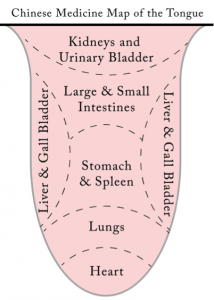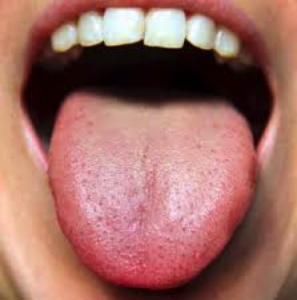Some of the most common questions I receive during an appointment are about the tongue: why we look at it, what do we see, and most importantly, what do we learn. It seems so strange, in this modern life, to look at tongues — but maybe not so strange, since they can tell us so much. When Chinese medicine was developed thousands of years ago, the doctors relied heavily on observation for diagnosis. They did not have labs or MRIs, so instead they were focusing on listening to the patient and observing what the patient’s body was trying to communicate. The body gives us so much information — if we know what to look for.
The tongue is divided into different areas, and these areas reflect the Chinese medicine organ system. The color of the tongue, its shape, its coating or lack of, all these details can give us information about what is going on internally. Ideally it looks like the tongue of a six- or seven-year-old child (if you have access to one, check it out). It is pale red with a thin white coating, and a rounded, “normal” shape. When we aren’t in the best of health, changes to the color, coating, and shape give clues to what’s wrong.
Redness in the tongue body indicates heat, and the location of the redness tells us the location. When you are catching a cold, you can often see redness on the tip of the tongue, indicating some heat entering into the lung. Or if you are feeling very anxious, or having some insomnia, redness on the tip can show up as well, indicating heat in the heart.
Pale pink to white tongue body usually indicates some type of blood deficiency or weakness, which may present with fatigue and lassitude.
A swollen looking tongue, either puffy or with toothmarks indicates there is dampness or difficulty with fluid metabolism. You may notice that you are retaining fluids, or your tummy may feel bloated.
Cracks on the tongue coating can indicate that your nourishing fluids are burned out, just like the earth cracks when it becomes dry. You may feel hot at night, or notice dryness in your skin or eyes.
A thick tongue coating can indicate dampness in the system. Dampness can be likened to sludge, and often times may indicates issues with digestion.
Now look at this one, notice anything?
As an acupuncturist, we notice that the tip of the tongue is red, with small red dots. The coating gets a bit thicker in the back, and is yellowish in color. Also, if you look closely on the sides, you can see that they appear just a bit swollen; there may even be a toothmark present. Without knowing what is going on with this patient, I could guess that she is experiencing some heat in her body.
If you are interested in learning more, here is a great resource at the Sacred Lotus Chinese Medicine website.
I encourage you to look at your tongue every day, first thing in the morning, and notice what you see. Look for changes, look at its shape, and pay attention to how you are feeling.
There are many ways to understand what our bodies are trying to tell us, and using the tongue is one way we can diagnose the imbalances. The history of Chinese medicine reflects the great strength that can be found from looking deeply at a person: at the color of their skin, the light in their eyes, the qualities of the pulse, and the features of the tongue. We have all stepped farther and farther away from this interaction, relying instead on technology to tell us when we are sleeping enough, when we are exercising enough, and when we are healthy or well. While technology has its place, it’s important to retain the ability to look and listen to our bodies’ messages ourselves.
[written by Julie]

